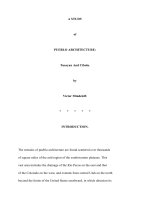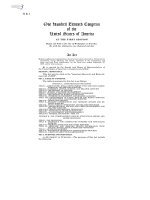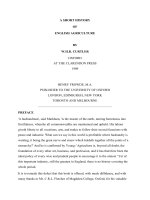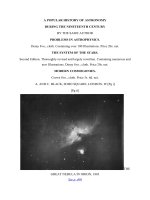HOW THE EURO BECAME OUR MONEY - A SHORT HISTORY OF THE EURO BANKNOTES AND COINS doc
Bạn đang xem bản rút gọn của tài liệu. Xem và tải ngay bản đầy đủ của tài liệu tại đây (4.85 MB, 94 trang )
A SHORT
HISTORY OF
THE EURO
BANKNOTES
AND COINS
HOW THE
EURO BECAME
OUR MONEY
HOW THE EURO
BECAME OUR MONEY
A SHORT HISTORY OF
THE EURO BANKNOTES
AND COINS
FOREWORD 7
CHAPTER 1:
A DECADE IN PREPARATION
9
Issuing euro banknotes and coins
10
Naming the currency and creating
the € symbol 10
Fixing the denominations
12
Timing the introduction of
the new currency 12
CHAPTER 2:
DESIGN
17
Selecting a design theme for the banknotes 18
Creating user-friendly banknotes 22
Ranking the designs 22
Consulting the public and making
the final decision 24
Designing the euro coins 28
Preparing the final designs 30
Appendix: Excerpts from the design
brief for the euro banknotes 33
CHAPTER 3:
PRODUCTION
35
Printing prototype banknotes 36
Test banknotes 36
Creating printing plates 37
Zero-production run 38
Establishing a quality management system 40
Legal and security issues with suppliers 41
Paper-making 42
Printing 44
Managing the large-scale production of
euro banknotes 48
2/3
CHAPTER 4:
CHANGEOVER
51
Estimating how many banknotes to print 52
Banknote circulation and banknote stocks 54
Stock management scheme
for the changeover 55
Early distribution of banknotes and coins 56
Frontloading and sub-frontloading 59
Facilitating the cash changeover for retailers 60
Putting euro cash into circulation 60
Withdrawing national banknotes and coins 62
Adapting cash dispensers and cash-
operated machines 64
Exchanging national banknotes at face value 66
CHAPTER 5:
COMMUNICATION
69
Preparing the public for the changeover 70
Euro 2002 Information Campaign 72
Partnership programme 73
National communication efforts 74
Campaign research 76
Campaign website 78
Press activities and public relations 79
Mass media campaign 80
CHAPTER 6:
SECURITY FEATURES
OF EURO BANKNOTES
83
CHAPTER 7:
CURRENT AND FUTURE
DEVELOPMENTS
89
BECAME OUR MONEY
FOREWORD
6/7
Europe’s single currency – the euro – came into
being on 1 January 1999. But it remained a “virtual”
currency, mainly used by banks and the financial
markets – for three years thereafter. For most
people, it did not become a “real” currency, visible
and tangible, until 1 January 2002. That was the
starting date for the introduction of euro
banknotes and coins. They are now an everyday fact
of life for more than 300 million people in Europe.
The introduction of the new cash in 12 European
countries – like the launch of the currency itself –
was a historic event, involving years of meticulous
planning and preparation. “How the euro became
our money” tells the story behind the history; it
covers the long sequence of decisions and actions
which took the cash from drawing board to printing
plant, from central bank to wallet.
There were numerous challenges – as well as
difficulties and risks – to be overcome by the
European Central Bank (ECB), the central banks
and governments of the euro area countries, the
European Commission, banknote printing works,
mints as well as by people in many other fields,
especially banks and shops.
The logistical preparations for the banknotes and
coins go back to 1992, when nobody knew what
they would look like, and when the new currency
did not even have a definitive name. The design issue
was resolved in 1996 when the ECB’s predecessor,
the European Monetary Institute, chose the final
banknote designs after holding a competition. By
1998, the pilot print run was launched. Delivery of
the cash to banks and shops started four months
before €-day, 1 January 2002. During this period,
millions of cash dispensers and vending machines in
the euro area were modified.
Communications too formed an essential part of
the preparations. Everyone had to know what the
euro would look like and how they would exchange
their old currencies for the new one. The message
was spread as broadly as possible via TV
commercials, print adverts, the internet and other
channels, and a pivotal role here was played by the
Euro 2002 Information Campaign, conducted by the
ECB and the 12 national central banks in the euro
area. Governments, public institutions as well as
commercial and voluntary organisations also
worked closely together to ensure the information
was received by all.
In the end, the launch went smoothly, and the new
banknotes and coins have become an integral part
of our lives, at home and abroad. I hope you will
enjoy reading about how this happened, about how
the euro cash became our money.
Jean-Claude Trichet
European Central Bank
A DECADE IN
PREPARATION
The Limburg Government building in Maastricht where the Governing Council of
the ECB met to mark the tenth anniversary of the Maastricht Treaty, which was
signed in 1992.
ISSUING EURO BANKNOTES
AND COINS
Euro banknotes and coins were put into circulation
in 2002, but the planning and preparation of their
introduction goes back to the early 1990s. On
7 February 1992, the Treaty on European Union was
signed in Maastricht. It describes the competencies
of the European Central Bank (ECB) and of the
governments and central banks of the 12 euro area
countries with regard to the issuing of euro cash. It
stipulates that the ECB has the exclusive right to
authorise the issuance of banknotes within the euro
area, but both the ECB and the national central
banks (NCBs) may issue them. However, since the
ECB is not involved in any cash operations, it is the
NCBs that actually put the banknotes into
circulation and withdraw, process and store them.
The banknotes in circulation are reflected in the
balance sheets of the ECB and the NCBs according
to a fixed key, regardless of the country in which
they are actually circulating. In fact, the number of
banknotes circulating in any one country can no
longer be determined because of unrecorded
cross-border cash flows in the euro area due, for
example, to tourism.
Responsibility for euro coins lies with the national
governments, coordinated by the European
Commission in Brussels. Euro area governments are
the legal issuers of euro coins and, as such, are
responsible for the designs and technical
characteristics of the coins and for their minting.
The ECB, however, is responsible for approving
annually the volume of euro coins to be issued; it
also acts as an independent assessor of the quality
of the minted coins.
NAMING THE CURRENCY AND
CREATING THE € SYMBOL
At the meeting of the European Council in Madrid
in December 1995, Europe’s leaders decided on the
currency’s new name: the euro. Other suggestions
were rejected because of their national
connotations. These included the “ducat”, “ecu”,
“florin”, “franken”, or using the euro as a prefix to
existing currency names – “euromark”, for
example. They agreed that the name should be the
same in all official languages of the European Union
(EU), taking account of different alphabets, and easy
to pronounce. Above all, it had to be simple and
representative of Europe.
The currency also needed to have a symbol. Like
the name, the symbol had to be clearly associated
with Europe, easy to write and attractive. A list of
thirty possibilities drawn up by European
Commission staff was reduced to ten and these
became the subject of a public survey. From this
shortlist, two possible symbols emerged and the
final choice was made by the then President of the
Commission, Jacques Santer, and Yves-Thibault de
Silguy, the Commissioner in charge of Economic
and Financial Affairs at that time.
The euro symbol was inspired by the Greek letter
epsilon, reflecting the cradle of European
civilisation. E is of course the first letter of the word
Europe. The two strong parallel horizontal lines are
intended to symbolise the stability of the currency.
The official abbreviation of the euro, EUR, has been
registered with the International Organization for
Standardization (ISO).
10/11
The euro symbol according to ISO standards. The two parallel
lines aim to emphasise the stability of the currency.
© European Community
Fixing the denominations
In November 1994, the Council of the European
Monetary Institute (EMI), the ECB’s predecessor,
decided on a sequence of 1:2:5 for the seven euro
banknote denominations: ?10 and ?100; ?20 and
?200; and ?5, ?50 and ?500. This sequence is in
line with the common denominational split of most
of the world’s currencies and also corresponds to
the sequence of the euro coins: 1 cent, 10 cent and
?1; 2 cent, 20 cent and ?2; 5 cent and 50 cent, as
agreed by the EU’s Economic and Financial Council
(Ecofin).
The decision to have a very high-value banknote –
?500 – was made after careful evaluation. Prior to
the changeover to euro cash, six of the euro area
countries – Austria, Belgium, Germany, Italy,
Luxembourg, and the Netherlands – had national
banknotes worth between ?200 and ?500, and
were using them increasingly. In 2000, for example,
the demand for DM 1,000 banknotes (equivalent
to ?511) was 15 times higher than in 1975 and
represented 34% of the total value of Deutsche
Mark banknotes in circulation. Moreover, in
countries outside the European Union with
relatively unstable monetary regimes, where
inflation is high and/or there is little trust in the
banking system, people often hold the cash of low-
inflation currencies as a store of value. Before the
introduction of euro banknotes, high-value notes
such as the DM 1,000 were held.
Three EU countries – Greece, Italy and Austria –
used very low-value banknotes (below ?2) prior
to the euro cash changeover. But the issuance of
both very high and very low denominations would
have created a banknote series with too many
denominations. It would also have made the notes
less user-friendly and complicated their handling
and storage. Therefore, ?2 was chosen as the
highest-value coin and ?5 as the lowest-value
banknote.
timing the introduction
oF the new currency
At the Madrid European Council, the heads of state
and government agreed that euro banknotes and
coins would start to circulate alongside the national
currencies at the latest by 1 January 2002. The
precise date, sometime between 1 January 1999
and 1 January 2002, was left open in order to take
account of the different preferences of various cash
users and the long lead times for printing banknotes
and minting coins.
The date of 1 January 2002 had both advantages
and disadvantages. The peak period for banknote
use is at the end of the year: circulation is around
10% higher than average because of the Christmas
season and the first few days of January are
traditionally a sales and stocktaking period for
retailers. A number of other dates were considered
but, in the end, 1 January 2002 was agreed to be the
most convenient date, marking the start of the
calendar year and being the date expected by
national public administrations. The Madrid
European Council also decided that the euro
should circulate alongside the national currencies
for a maximum of six months, although
subsequently, the pros and cons of shortening this
period were discussed. A shorter period would
reduce the costs of handling two currencies
simultaneously for banks, retailers and the public,
while a longer period would make it easier to adapt
vending machines. A compromise was reached and
it was decided to shorten the transition period. In
November 1999, Ecofin agreed that the period of
dual circulation should last between four weeks and
two months. Banks would continue to change
national currencies into euro after that period but
those currencies would no longer be legal tender.
12/13
Some of the national banknotes replaced by the euro.
14/15
Government leaders at the Madrid European Council meeting, 15–16 December 1995.
© European Community
The Madrid European Council meeting, with Felipe González (left), then Spanish Prime Minister and
President-in-Office of the Council, and Jacques Santer, then President of the European Commission.
© European Community
DESIGN
A collage of entries for the euro banknote design competition.
SELECTING A DESIGN THEME
FOR THE BANKNOTES
The most important factor in the design of a
banknote is its “resistance” to counterfeiting. But
a banknote – and especially a series of banknotes
destined for use in a large group of countries –
should also look attractive. Euro banknotes needed
to be acceptable to everyone in the euro area,
if not beyond. The notes would be circulating
across borders in a variety of cultures and had to
avoid any national or gender bias. This impartial
approach was taken into account when choosing
the design theme. The notes should also allow
the incorporation of aesthetically appealing design
features.
In November 1994, the Council of the European
Monetary Institute asked the Banknote Working
Group to make proposals for design themes
for the euro banknote series. The group, which
was made up primarily of the chief cashiers (the
persons responsible for issuing banknotes) of the
national central banks and general managers of
the printing works owned by the central banks,
worked closely with an external advisory body, the
Theme Selection Advisory Group, which consisted
of experts in the fields of history, art, psychology,
general design and banknote design.
The Advisory Group was asked, first, to suggest
themes that would create a sense of unity or form
a “family” of the seven banknote denominations,
and second, to select the three best themes and
rank them. As the banknotes needed to be quickly
and easily recognisable as European both inside and
outside the European Union, it was decided that
they should depict the flag and/or stars of the EU.
These symbols have become increasingly used by
the different nations with different histories that
live and work as partners on the same continent.
18 themes were initially selected, but many of them
tended to reflect a national focus or interest:
In the end, the Advisory Group proposed the
following three themes:
• “Ages and styles of Europe”: one side of the
banknote would show portraits of ordinary
men and women taken from European paintings,
drawings and sketches across the ages; the
other side would show architectural styles. The
idea was to choose a theme that stressed the
common cultural heritage of the nations of
Europe and carried a clear European message
worldwide. After all, Europe’s most famous
buildings or landmarks are better known than
the continent’s leaders.
18/19
• AgesandstylesofEurope
• HeritageofEurope
• Abstractthemeandsecurity
• Aims,idealsandaspirationsoftheEuropean
Union
• CollectivememoryofEuropeandcultural
achievements of Europe
• Fauna,floraandthenaturalenvironment
• GreatEuropeanfiguresassociatedwitha
single discipline
• AspectsofEurope(thingsvitaltotheexistence
of a united Europe, e.g, communications)
• GreatEuropeanpoemsandnarratives
• Severalportraitsonbothsidesofeach
banknote denomination
• Landscapes
• Citiesthatplayedanimportantrolein
Europe’s history, e.g. university towns
• Monuments
• Mythsandlegends(Scandinavian,German,
Greek, Roman and Celtic)
• Europeanscriptsandwrittenwork
• MapsofEuropethroughtheages
• The“foundingfathers”oftheEuropeanUnion
• Cosmology
• “Heritage of Europe”: one side of the banknote
would show illustrations of famous men and
women from the past; the other side would
show achievements in fields such as music,
painting, science, architecture, literature,
medicine and education. All seven banknotes
would incorporate, as a background, a map of
Europe without borders, a feature which would
harmonise the appearance of the series. This
theme was broader than the “Ages and styles”
theme as it allowed seven distinct disciplines
to be portrayed. However, striking a balance
between the countries and also between the
depiction of men and women was likely to be
difficult.
• “Abstract theme and security”, later renamed
“Abstract/modern design”, involved geometric
shapes and non-figurative design elements.
It offered a high degree of design flexibility
and would make it easier to include a wide
range of security features, such as holograms
and colour-shifting inks. It also allowed very
different approaches, so impartial designs were
fairly easy to achieve.
In June 1995 the EMI Council approved two of the
three proposals: “Ages and styles of Europe” and
“Abstract/modern design”. It also agreed that the
only words to appear on the banknotes would be
the name of the currency and the initials of the
ECB in the different languages. A Feature Selection
Advisory Group was commissioned to define the
periods and the related architectural styles for the
“Ages and styles of Europe” theme:
Period
Style
Eighth century BC to fourth century AD
Classical (Greek and Roman)
Eleventh and twelfth centuries
Romanesque
Thirteenth and fourteenth centuries
Gothic
Fifteenth and sixteenth centuries
Renaissance
1600 to 1750
Baroque and rococo
1850 to 1914
Age of iron and glass
From the 1930s onwards
Twentieth century architecture
20/21
The group also selected design motifs typical
of each style for optional use by the designers.
Most members of the group concluded that it
was virtually impossible to find totally anonymous
features that would – in the case of portraits – be
both attractive and impartial in terms of country
and gender. For this reason, many of the draft
design proposals made reference to sculptures,
such as the head from a statue of an athlete
(Classical period, envisaged for the ?5 banknote)
and the sculpture of a head in Parma Cathedral by
Benedetto Antelami (Romanesque period, for the
€10 banknote).
At the time of these discussions, specific national
design features for the banknotes were still an
option. They would identify the country that issued
the banknotes. A national feature, for example, the
portrait of a monarch, could cover up to one-fifth
of the reverse side. The rest of each banknote
would be identical.
Design briefs were drawn up which specified the
criteria to be met by the designers. Apart from being
attractive, easy to recognise and difficult to fake,
the banknotes needed to incorporate security
features in certain positions, have particular
colours and clearly contrasting value numerals.
These specifications extended to 30 pages and
mainly covered the technical descriptions of the
security features. Some excerpts from the design
brief for the “Ages and styles of Europe” theme are
reprinted on pages 32 and 33.
Several designers used the Ephebe of Antikythera (a classical
Greek statue) as a design motif for the euro banknotes.
The euro banknote designs are based on the “Ages and styles of Europe” theme.
22/23
CREATING USER-FRIENDLY
BANKNOTES
Changing an element of daily life as fundamental
as banknotes and coins means that everyone is
affected. Visually impaired people – and there are
more than 7 million of them in the euro area –
are particularly affected. The European Monetary
Institute worked closely with the European Blind
Union from 1995 onwards in respect of both the
design and size of the banknotes. This vulnerable
group, for obvious reasons, had to be able to handle
them easily; if they could do so, then everyone else
could.
Each banknote – whether €5 or €500 – had to
be readily identifiable by people with residual
or no sight. For example, the differences in
height between the lower, more commonly used
denominations were quite distinct. The €100, €200
and €500 banknotes were made the same height
– to facilitate automatic handling – but repetitive
embossed patterns were placed on the €200 and
€500 banknotes to differentiate them.
Large and bold value numerals were placed in
a standard position throughout the series, on
both sides, and sharply contrasting colours were
used. They were derived principally from the
colour wheel of the Swiss painter and art teacher
Johannes Itten (1888-1967). The colours chosen
for successive denominations were taken from
opposing segments of the colour wheel and thus
strongly contrast with each other. The same is true
for denominations that have digits in common, like
the red €10 and green €100 banknotes.
RANKING THE DESIGNS
The designers were nominated by all the central
banks in the European Union (except Denmark’s)
and each central bank could name up to three
designers. All those chosen had experience of
banknote design and were familiar with the challenge
of combining attractive designs with effective
security features. They were asked to submit
draft designs for the complete series of banknotes
showing one or both themes within seven months.
Each proposal would be presented to the EMI
Council as a colour copy, but no production
technique was specified, so some designers
produced hand paintings or drawings while others
produced computer-generated designs.
A total of 29 designers or design teams submitted
27 proposals with the “traditional” theme and
17 with the “modern” theme by the closing
date of the competition, 13 September 1996. Each
design series was then given a random three-digit
number to make it anonymous, and sent to the
EMI. At all selection stages, the draft designs were
only identifiable by their respective number. This
ensured that the EMI Council and the advisory
bodies would assess the entries objectively, and
not be influenced by the country or origin.
Towards the end of that month a jury of independent
experts in marketing, design and art history met
under the chairmanship of the EMI in order to
select the five best designs for each theme. The
designs were judged mainly on the basis of creativity,
aesthetics, style, functionality as well as
likely public perception and reception. The jury
agreed that a European “look” for the banknotes
would be of paramount importance. This also
explains why portraits did not feature very largely
in the designs chosen by the jury: even a slight
similarity to a real person could be interpreted as
demonstrating national bias. During the selection
process, the jury was encouraged to make
comments on design details in case a design
series was generally well regarded but required
amendments.
The ranking took place in a three-step procedure;
those design series not supported by a minimum
number of jury members were discarded. Robert
Kalina’s design – which would be selected by the
EMI Council two months later – was ranked second
in the category “Ages and styles of Europe”. The
jury said that “it clearly represents European money.
Although it is based on only one main design idea, it
excels on account of the interesting and meaningful
selection of architectural features. … A very clear
distinction between the denominations is achieved by
the skilful use of colours and the strong numerals.”
Initially, the design series was chosen because of its
concept, not its beauty. When the jury’s ranking was
combined with the public’s response in an opinion
poll, Kalina’s design was judged to be the best.
The jury’s shortlist was as follows:
Abstract/modern theme
1. Klaus Michel and Sanne Jünger
2. Roger Pfund
3. Robert Kalina (Oesterreichische Nationalbank)
4. Maryke Degryse (Banque Nationale de
Belgique/Nationale Bank van België)
5. Terry Thorn (Harrisons & Sons)
Ages and styles of Europe
1. Yves Zimmermann
2. Robert Kalina (Oesterreichische Nationalbank)
3. Ernst and Lorli Jünger
4. Inge Madlé (Joh. Enschedé)
5. Daniel and Johanna Bruun
24/25
In parallel to the public survey, the EMI’s Banknote
Working Group assessed the draft designs from
the following perspectives:
• production, e.g. would the design create
production problems resulting in extra spoilage/
wastage and/or a sharp increase in production
costs?
• security, e.g. does the design properly
incorporate the security features and would
they be compatible with it?
• publicacceptability,e.g.canthedenominations
be easily identified, also by visually impaired
people?
The first draft designs of banknotes are usually
modified to comply with printing requirements, so
the final design differs from the earlier versions. The
Banknote Working Group concluded that if certain
changes were made all the shortlisted series could
be converted into printed banknotes.
In December 1996, all 44 designs – anonymised
colour copies – were presented to the EMI
Council on dark cardboard panels. The Council
was informed about the jury’s ranking, the results
of the public survey and the technical comments
of the Banknote Working Group. The Council
members quickly approved the traditional series
designed by Robert Kalina; they found the message
it conveyed so striking that most of them ranked it
first. This decision was announced on 16 December
1996 at two parallel press conferences: one at the
EMI in Frankfurt by the EMI President, Alexandre
Lamfalussy, and the other at the Dublin European
Council by the Governor of the Netherlands’
central bank, Willem F. Duisenberg (who was
designated as Lamfalussy’s successor at the EMI and
later appointed as the first President of the ECB).
CONSULTING THE PUBLIC AND
MAKING THE FINAL DECISION
All ten design series shortlisted by the jury were
shown to a cross-section of the public in October
1996 in the countries likely to be participating in
the euro area. A market research company spent a
week interviewing 1,896 people about the designs.
The interviewees were aged between 15 and 86,
with 43 being the average. 787 of them said that
they handled a large number of banknotes in their
daily work.
A higher proportion of interviewees (35%)
preferred the abstract/modern designs by Maryke
Degryse to the traditional designs by Robert Kalina
(23%). But most interviewees – 76% – felt that
Kalina’s banknotes better expressed the idea of
“Europe”; only a few said it reminded them of a
particular region or specific country. His traditional
series was felt by 60% to inspire confidence. It
is interesting to note that studies show that, in
general, the more a banknote is immediately liked,
the more it inspires confidence.
The interviewees were asked around 30 questions
under the headings of perception, emotion and
acceptance. All designs, except the series by Roger
Pfund and the modern series from the Jünger team,
were perceived as banknotes at first glance. Those
two series, and the one by Terry Thorn, reminded
the respondents more of pieces of art than means
of payment.
The poll revealed that in Robert Kalina’s design:
• the architectural drawings are the main eye-
catcher, but people said they quickly noticed
that Europe was a key element;
• the European identity that is depicted is
multiple, unique and dynamic, and it combines
the continent’s past with its future.









